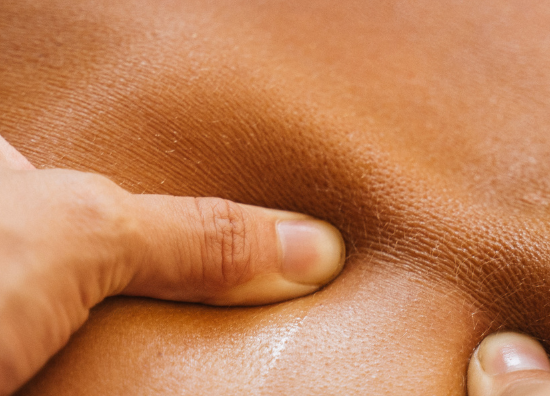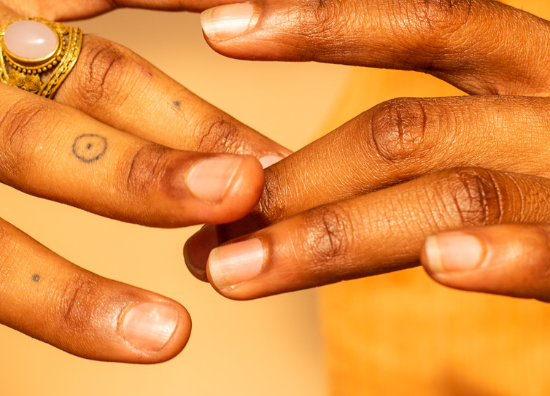Learning to consciously relax muscular tension
There’s a beautiful Chinese proverb that says, “Tension is who you think you should be. Relaxation is who you are.” I find this to be profound and insightful, and it mirrors so much of what I see in my clients’ bodies. Many people coming to me for intimate bodywork sessions think that they have a specific problem with sex, or just with their genitals, but it soon becomes clear that they’re carrying a far broader internal struggle throughout their entire body. Unconscious tension and contraction in the shoulders, jaw, hips, belly, buttocks and back are creating a blockage in their ability to feel any deep sensation or pleasure.
Most of us don’t realise we’re clenching or bracing until someone draws our attention to that place. Many clients don’t realise they’ve stopped breathing until I remind them to take a breath. Most can only feel that they were contracting an area of the body after I’ve been holding touch there for some moments, and gradually that muscular tension releases.
If you’ve ever asked yourself ‘why am I so tense all the time’ then this article will help you understand why we hold tension, how to become more conscious of it, and how to let it go – not just as a physical release, but as a shift in the way you relate to and inhabit your body.
The invisible armour we wear
Muscular tension is not just a physical state – it’s often emotional, psychological, even cultural. We tense our bodies in response to stress, fear, shame, urgency, insecurity, and many other triggers. Some of us live in a near-constant state of readiness, like a soldier waiting for an ambush that never comes. We also learn to use tension as a way to suppress feelings that might be ‘too much’ – too angry, too sexual, too soft, too messy. The unconscious tension your body is carrying doesn’t originate in the muscles themselves – which is why simply having a massage is not a long-term solution. This background ‘scrunch’ setting is controlled by your nervous system and the complex relay of electric signals between your brain and the muscle fibres. Your nervous system learns to respond to life in order to keep you as safe as possible, but in our modern lives that mechanism can get hijacked and we get stuck in a constant state of background tension.
We’re taught from a young age to sit up straight, hold our bellies in, clench our buttocks, and minimise our emotional expression. Tension becomes a kind of mask we wear – a way of saying, ‘I’m in control,’ even when we’re not. It’s an effortful performance of who we think we should be. But over time, that performance can starts to hurt, and take us further away from who we really are. Your body is designed to move easily between states of readiness – more muscle ‘tone’ – and states of relaxation – less muscle ‘tone’. All the unconscious messaging, the poor habits and the emotional blocking interrupt this process and can leave us feeling like we’re stuck in a medieval suit of armour.
Becoming aware of holding patterns
Most of the muscular tension in your body is unconscious. You don’t choose to grip the steering wheel so tightly that your knuckles go white. You probably don’t notice you’re clenching your jaw and holding your breath while you answer emails. You don’t intend to suck in your stomach every time you walk past a mirror. You don’t realise you’re bracing your stomach and blocking the flow of pleasure whilst you’re having sex. It just happens on autopilot. These are what bodyworkers and somatic therapists call ‘holding patterns.’ They’re the habitual muscular contractions that have become part of your default operating system. You won’t notice them until you slow down, pay attention and pause long enough to notice.
Start with this:
Right now, as you’re reading this – can you feel your shoulders? Are they lifted, tight, or scrunched?
How about your belly? Can you let it soften?
What’s happening in your jaw? Your tongue? Your brow?
Awareness is the first step. You can’t release what you haven’t yet felt.
Why do we hold tension?
The body is smart. It doesn’t create tension for no reason. Every clench is a response to something – often a past experience that taught us it wasn’t safe to relax. If you were shouted at for being lazy, you might carry a constant drive to do more. If you were taught to suppress your emotions, your diaphragm might stay frozen, and your breath shallow. If you’ve ever been objectified, criticised, or hurt, your muscles might have learned to armour themselves – to reduce the amount of movement and sensation in your body, and protect you.
That protective tension can be brilliant in the short term. It’s your nervous system doing its job. However, if you never give yourself a way to release it, then it can become chronic. When clients ask me ‘why am I so tense all the time’ this is what they’re experiencing: a default state of constantly bracing against life… it’s exhausting. Letting go of that tension can feel vulnerable – sometimes even unsafe. I’ve personally had experiences with bodywork where I’ve realised that I feel like my entire body will crumble if I let go of the tension. It’s not just about relaxing the muscles, it’s about helping your nervous system learn that it’s OK – and completely natural – to soften.
Practicing conscious relaxation
So how do we start to let go? If you want to change the default setting of tension in your body you need to consciously practice doing the opposite. Here are my top tips for bringing more awareness and relaxation into your day.
1. Slow down and listen
In our busy lives we’re operating mostly from our ‘working mind’ – typically Beta or Gamma brainwave frequency. These are linked to active processing, stress, muscular readiness and low-level tension. You’re not physically relaxed. If you’re going to stand any chance of moving out of those frequencies you have to begin by intentionally creating quiet moments that allow you to slow down. Turn off distractions. Close your eyes. Turn your attention inwards and try a simple body scan:
- Start at the crown of your head, and gently bring awareness to each part of your body, moving all the way down to your feet.
- You don’t have to do anything with each part, you’re just consciously putting attention there.
- Let go of judgment and simply feel. You’re not trying to fix anything. You’re just listening.
- You can use my body scan meditation as a guide.
This practice will typically drop you into more alpha wave brain activity: calm and relaxed, but awake – a gateway into physical and mental relaxation. It might be challenging at first, and you might not feel any immediate shifts in your body tension but remember the effect is cumulative. If you do this for 3-5 minutes every day for a month I guarantee you will have a deeper connection to your body, and will be able to identify and interrupt the constant bracing patterns.
2. Breathe into it
The breath is the bridge between body and mind. Shallow, restricted chest breathing signals danger; deep belly breaths tells your brain and body that you’re safe. If your nervous system is regularly softened with intentional slow breathing you’ll find it easier to switch out of the ‘muscular readiness’ state. Try this:
- Lie on your back, knees bent and feet on the floor. Place one hand on your belly, the other on your chest.
- Breathe in through your nose for a count of four, allowing the belly to rise.
- Exhale slowly through your mouth for a count of six, letting the jaw relax.
- Repeat a few times. Feel what changes.
You don’t need to by lying down to access the relaxation of deep breathing. Make it a practice to bring more awareness to your breathing throughout your day.
3. Use gentle movement
Sometimes tension won’t release just by thinking about it, especially when the body feels stuck and frozen. You need to move.
Try gentle, intuitive movements:
- Rolling the shoulders
- Rocking the pelvis
- Yawning and stretching
- Shaking out your limbs
- Stretching and opening the hands
Make it non-linear: going to the gym and doing squats doesn’t count here. Even a yoga class can be a rigid, routine way of moving. Just move like someone who is slowly, gently wriggling out of a too-tight costume. Put some music on that helps you feel into the emotions of the day and just let it all out. This kind of movement will stretch and lubricate the joints and the fascia, and help break your body out of the freeze.
4. Touch with presence
Touch is powerful. Whether it’s your own hands or someone else’s, a conscious massage can help guide the body back to softness. During bodywork you’re likely to get access to the Theta frequency of brainwaves – this is deep relaxation where the body starts to release stored tension. This is where my clients often experience ‘spontaneous’ muscle release – sometimes as trembling, or little twitches through the body. This is harder to access with self-touch (as you’re still alert and ‘doing’) but even placing a warm hand over your heart, your belly, your hips or your neck can work wonders. Explore stillness – you don’t need to force out ‘knots’ in the muscles. Remember you’re working at the nervous system level, not the muscle fibre level. Simply holding and meeting your body in a way that says ‘you’re safe, it’s OK to relax, there’s no pressure to do anything right now’, will help you find deep relief from the daily clench.
5. Let yourself feel
Sometimes, when we do finally relax a muscle, there’s a big rush of emotion – grief, relief, even hysterical giggles. This is normal. The constant low-level muscle tension often acts like a dam, holding back what we didn’t feel safe to feel during the day/week/month/entirety of our life! If tears come, let them. If laughter bubbles up, beautiful. If you feel numb, bored, or distracted that’s okay too. Learning to relax is a process of learning to trust that it’s OK to feel – both the physical sensations and the emotional sensations.
Who you are beneath the armour
Relaxation isn’t about giving up, zoning out, or being lazy. It’s about getting real with yourself. It’s about noticing what your body has been doing to keep you functioning – and making a conscious choice to stop over-efforting all the time.
Tension often comes from trying to manage things, prove something, or stay in control. But the truth is, that constant holding pattern usually just drains your energy and disconnects you from your actual needs. Learning to let go isn’t weakness. It’s a skill. It takes awareness, practice, and sometimes courage.
So next time you catch yourself gripping, rushing, bracing, or faking calm, pause and check in:
Where is this creating tension in my body?
Do I really need that?
And then try softening, let the breath deepen, and you might be surprised at what happens when you stop holding it all in.
If you’re interested in learning more about regulating your nervous system, to feel more relaxed during sex and intimacy (as well as in daily life), then I recommend my online course in basic massage, intimate touch, and mindful masturbation. You can also get in touch to book a series of bodywork sessions to really get down into those Theta brainwaves! 🙂
With Love,
Libby



